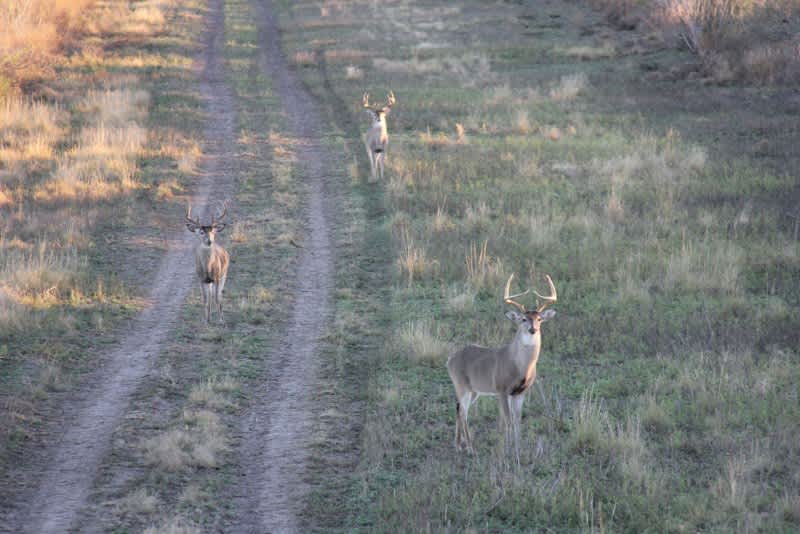Whitetail Vacation: Affordable Deer Management Hunts in Texas
Bernie Barringer 02.09.16

A management hunt in Texas is a great way to get away from harsh winter while experiencing a unique hunt for a bargain price.
For all practical purposes, modern trophy management for whitetail deer began in Texas. Three decades ago, owners of large ranches implemented practices that they felt might improve the quality of the deer they were seeing. Today, these efforts have come to fruition, as Texas produces thousands of whitetail bucks with huge racks each year. But the efforts are ongoing, with a continual striving to take the deer to another level.
The management includes several factors, but some of the most important include selective harvest, predator control, and providing quality feed. The feed is not only a key to growing big bucks, but it’s also a key to having an opportunity to shoot one.
South Texas is thousands of square miles of thorny brush, some of the most inhospitable country in the United States. If it weren’t for two things, you would never get a chance to shoot a buck. Ranchers have cut long-running road, called senderos, through the brush. They feed corn, hay, and cottonseed at the intersections of these senderos. This is where deer step out into the opening so a hunter can get a look at them. Hunters sitting in box blinds have an opportunity to look over the deer and choose which ones they want to shoot. It’s a perfect way to selectively harvest the right bucks for improving the herd.
Most of these ranches are working cattle ranches and many are producers of oil. Now there is a third product—ranch owners have figured out that there is a lot of money in whitetails. Many ranches have several full-time employees that just run their deer management operations. Many of these ranches are upwards of 200 square miles in area. Sometimes the deer hunting rights for parcels are leased out, sometimes the ranch runs the hunts themselves, and with many of the larger ranches, it’s a combination of both.

That’s the case with the Duval County Ranch, where I hunted. Much of the 130,000-acre ranch is leased, but they also offer guided hunts. Like many ranches that have been under strict management for decades, this ranch produces dozens of 160- to 180-class whitetails every year. Hunts for these trophy deer are out of reach for the average working man at $7,000 to $10,000 per hunt.
But some deer must be culled each year, the ones with inferior antler genes, so that’s where people like me come in. A “management” hunt runs about one-third the cost of a trophy hunt and allows the hunter to experience this amazing country while hunting a cull deer. For many hunters, even a cull deer will be bigger than anything they have shot in their home state. Each ranch has their standards, but generally a cull deer is five years old with eight points or less that scores less than 140.
A management hunt includes food and lodging, both of which are normally superb. A guide will go out with you each day and help you age and score the deer you see, so you do not shoot the wrong deer. These deer are much smaller than their Midwestern counterparts I am accustomed to hunting, so the racks look huge in comparison to the bodies. Because these deer are well-fed and healthy, it’s hard to judge the older bucks from the younger. It takes some time to get good at it. Even a six- to seven-year-old deer, something you may never encounter at home, looks strong and lithe.
Some management hunts allow you to shoot other animals as well. Wild hogs are a problem and most ranches will let you hunt them when your deer tag is filled. Javelinas are everywhere—I saw them every day and the limit in that area was two. Coyotes kill a lot of fawns, and they are abundant on most ranches. They come to a predator call, which is another package deal many ranches offer.
Management usually requires that a certain number of does are shot each year to keep the buck-doe ratio nearly even. This means there is a lot of competition for breeding so the interaction between whitetail bucks is extreme. During December and early January, the rut is on, and bucks are fighting all over. You will hear the rattling and see the fights around the feeders. I even picked up a piece of broken antler near my stand.
Generally the does are shot early in the season, the management bucks are taken all through the season, but the trophy hunting takes place in January after the rut has wound down. This allows the majority of the big bucks to have a chance to breed before they are shot. Most trophy bucks are at least six years old before they are added to the list of deer that can be shot. This allows them to reach their full antler-growth potential.

The food and lodging are highlights of these hunts, the deer hunting and wildlife viewing opportunities from the stand is amazing, but one of the best parts of the hunt is the weather. I hunted the first week of January in shirt-sleeve weather when it was 22 degrees below zero at home in Minnesota.
The way these hunts take place on most ranches is not conducive to success with archery tackle, but some ranches do offer hunts that are set up just for bowhunters. All in all, a management hunt is an affordable vacation for the deer hunter. It’s an opportunity to see an abundance of deer and other wildlife in a unique environment. It’s a hunt that should be added to your bucket list.
Watch a video of my recent management hunt below.
Follow Bernie’s bowhunting adventures on his blog, bowhuntingroad.com.

